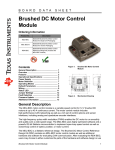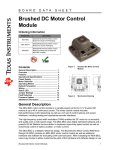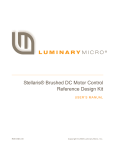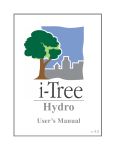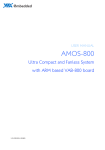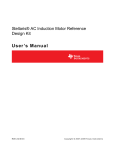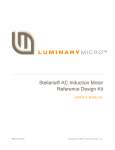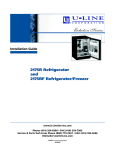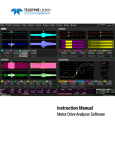Download MDL-BDC24
Transcript
B O A R D
D A T A
S H E E T
Stellaris® Brushed DC Motor Control
Module with CAN (MDL-BDC24)
Ordering Information
Product No.
Description
MDL-BDC24
Stellaris® Brushed DC Motor Control
Module with CAN (MDL-BDC24) for
Single-Unit Packaging
RDK-BDC24
Stellaris® Brushed DC Motor Control
with CAN Reference Design Kit (includes
the MDL-BDC24 module)
Contents
General Description ....................................... 1
Overview ................................................... 2
Detailed Features ...................................... 2
Operational Specifications ........................... 4
Servo-style PWM Input .............................. 8
Electrical Interface ..................................... 8
Power Supply ............................................ 8
Motor Selection ......................................... 9
Operating Modes ....................................... 9
Default Parameters .................................. 10
Wiring ...................................................... 10
Mechanical Details .................................. 11
Status LED .............................................. 12
Jumper Settings ...................................... 12
Fault Detection ........................................ 13
Calibration ............................................... 13
CAN Communication ............................... 13
Coast/Brake Input .................................... 14
Analog Input ............................................ 15
Encoder Input .......................................... 15
Limit Switch Inputs .................................. 16
Firmware Update ..................................... 16
Additional Information ................................ 16
Figure 1.
Brushed DC Motor Control
Module
3.50"
1.99"
2.00
3.85
Ø 0.175
4.25
Figure 2.
Mechanical Drawing
General Description
The MDL-BDC24 motor control module is a variable speed control for 12 V and 24 V
brushed DC motors at up to 40 A continuous current. The motor control module includes
high performance CAN networking as well as a rich set of control options and sensor
interfaces, including analog and quadrature encoder interfaces.
The high-frequency pulse width modulator (PWM) enables the DC motor to run smoothly
and quietly over a wide speed range. The MDL-BDC24 uses highly optimized software and
Stellaris® Brushed DC Motor Control Module with CAN (MDL-BDC24)
1
B O A R D
D A T A
S H E E T
a powerful 32-bit Stellaris microcontroller to implement open-loop speed control as well as
closed-loop control of speed, position, or motor current.
The MDL-BDC24 is a Stellaris reference design. The Brushed DC Motor Control Reference
Design Kit (RDK) contains an MDL-BDC24 motor control module as well as additional
hardware and software for evaluating CAN communication. After evaluating the
RDK-BDC24, users may choose to either customize the parts of the hardware and software
design or use the MDL-BDC24 without modification. For detailed circuit-level information
and reference design kit details, see the Brushed DC Motor Control Reference Design Kit
(RDK) User's Manual (available for download from www.ti.com/rdk-bdc24). Use the
MDL-BDC24 Getting Started Guide if you are using the MDL-BDC24 without modification.
Figure 2 shows the MDL-BDC24 motor control module from the top view.
Figure 2. MDL-BDC24 Motor Control Module
Overview
The MDL-BDC24 motor control board provides the following features:
Controls brushed 12 V and 24 V DC motors up to 40 A continuous
Controller Area Network (CAN) interface at 1 Mbit/s
Industry-standard servo (PWM) speed input interface
RS232 to CAN bridge
Limit switch, encoder, and analog inputs
Fully enclosed module includes cooling fan
Flexible configuration options with simple source file modification
Easy to customize—full source code and design files available
Detailed Features
This section describes the MDL-BDC24’s features in detail:
Quiet control of brushed DC motors
– 15 kHz PWM frequency
Stellaris® Brushed DC Motor Control Module with CAN (MDL-BDC24)
2
B O A R D
D A T A
S H E E T
Three options for Speed control
– Industry-standard R-C servo type (PWM) interface
– Controller Area Network (CAN) interface
– RS232 serial interface
CAN communication
– Multicast shared serial bus for connecting systems in electromagnetically noisy
environments
– 1M bits/s bit rate
– CAN protocol version 2.0 A/B
– Full configurability of module options
– Real-time monitoring of current, voltage, speed, and other parameters
– Firmware update
RS232 serial communication
– Bridges RS232 port to a CAN network
– Directly interfaces to a PC serial port or National Instruments cRIO
Status LED indicates Run, Direction, and Fault conditions
Motor brake/coast selector
Limit switch inputs for forward and reverse directions
Quadrature encoder input (QEI)
– Index input
– 5 V supply output to encoder
Analog input
– Accepts 10 kΩ potentiometer or 0-3 V input
Screw terminals for all power wiring
Headers (0.1 inch pitch) for all control signals
Stellaris® Brushed DC Motor Control Module with CAN (MDL-BDC24)
3
B O A R D
D A T A
S H E E T
Figure 3. Detailed Drawing of the MDL-BDC24 Motor Control Module
For power wiring use
12AWG Wire with # 6 ring
or spade terminals
Maintain 0.5 " clearance
around all vents
Motor output is not protected
against short- circuits.
From Power
Distribution
Module
(– ) In
Motor
Out
(– ) Motor
(+) Motor
(+) In
Mounting holes
3.50 " centers
User Switch
Maintain 0.5" clearance
around all vents
CAN Port
6P6C CAN/RS232 Port
Status LED
Limit switch inputs
Use hooks to prevent
wires shaking loose
Encoder Input
Analog input (0-3V)
Motor coast / brake jumper
Operational Specifications
The following tables provide the operation specifications for the MDL-BDC24 motor control
board.
WARNING – Do not exceed the maximum supply voltage of 30 VDC. Doing so will cause permanent
damage to the module.
Table 1.
Power Supply
Parameter
Min
Typ
Max
Units
5.5a
12/24
30
Vdc
Supply voltage absolute maximum
–
–
35b
Vdc
Supply current (motor off, fan off) (VIN = 12 V)
–
35
–
mA
Supply current (motor off, fan on) (VIN = 12 V)
–
105
–
mA
Under-voltage detect threshold
–
6.0
–
Vdc
Supply voltage range (VIN)
a. Power supply requires VIN ≥ 7.0 VDC to start up.
b. Exceeding this limit, even momentarily, will cause permanent damage.
Stellaris® Brushed DC Motor Control Module with CAN (MDL-BDC24)
4
B O A R D
Table 2.
D A T A
S H E E T
Motor Output
Parameter
Min
Typ
Max
Units
Motor voltagea
0
–
VIN
V
Motor current - continuous
–
–
40
A
Motor current – for 2 seconds
–
–
60
A
Motor current – peak at starting
–
–
100
A
PWM frequency
–
15.625
–
kHz
PWM resolution
–
0.1
–
%
Output current for resistive loadsb
–
–
30
A
a. The motor voltage is controlled by using a pulse-width modulated waveform.
b. The output current for resistive loads is continuous and the value shown is the maximum value.
Table 3.
Environment
Parameter
Min
Typ
Max
Units
0
–
50
°C
-25
–
85
°C
Fan on temperature
–
42
–
°C
Fan off temperature
–
38
–
°C
Min
Typ
Max
Units
Minimum pulse widtha,b
–
0.67
Neutral pulse widthb
–
1.5
–
ms
Maximum pulse widthb,c
–
2.33
–
ms
5.0125
–
29.985
ms
0.5
–
2.50625
ms
Duty cycle range
–
–
50
%
Digital high-level input current
2
5
25
mA
Digital low-level input current
–
–
0.3
mA
Watchdog time-out
–
100
–
ms
Voltage isolation (servo+/- to other signals)d
–
–
40
V
Operating temperature range
Storage temperature range
Table 4.
Servo-Style Speed Input
Parameter
Servo signal period
Valid pulse width range
ms
a. Sets full-speed in reverse.
b. These are the default values. Pulse-width range can be calibrated for different values. See the servo
PWM calibration procedure on page 13.
c. Sets full-speed in forward direction.
d. The servo input is optically isolated.
Stellaris® Brushed DC Motor Control Module with CAN (MDL-BDC24)
5
B O A R D
Table 5.
D A T A
S H E E T
Analog Input
Parameter
Min
Typ
Max
Units
Analog input voltage
0
–
3
V
Potentiometer value
–
10
–
kΩ
2.9
3.0
3.1
V
Measurement resolution
–
10-bit
–
bits
Measurement rate
–
15.625
–
kHz
Potentiometer reference voltage (+ pin)a
a. With 10 kΩ potentiometer connected.
Table 6.
Voltage, Current, and Temperature Measurement
Parameter
Min
Typ
Max
Units
Temperature measurement accuracy
–
+/- 6
–
°C
Supply voltage measurement accuracy
–
+/- 0.3
–
V
Motor current measurement accuracy ≥ 8A
–
+/- 1
–
A
Motor current measurement accuracy < 8A
–
+/- 2
–
A
Measurement resolution
–
10
–
bits
Measurement rate
–
15.625
–
kHz
Parameter
Min
Typ
Max
Units
Digital low-level input voltagea
-0.3
–
1.3
V
Digital high-level input voltageb
2.0
3.3
5.0
V
Digital input pull-down resistor
–
200
–
kΩ
Response time
–
64
–
µs
Power on Pin 1 (3.3 V)
–
–
25
mA
Table 7.
Brake/Coast Input
a. Selects Brake mode.
b. Selects Coast mode.
Table 8.
Quadrature Encoder Input (QEI)
Parameter
Min
Typ
Max
Units
Digital low-level input voltagea
-0.3
–
1.3
V
Digital high-level input voltagea
2.0
3.3
5.0
V
–
10
–
kΩ
Encoder rateb
DC
–
1
M
Encoder supply voltage
4.90
5.0
5.10
V
Digital input pull-up resistor
Stellaris® Brushed DC Motor Control Module with CAN (MDL-BDC24)
6
B O A R D
Table 8.
D A T A
S H E E T
Quadrature Encoder Input (QEI) (Continued)
Parameter
Min
Typ
Max
Units
–
–
100
mA
Min
Typ
Max
Units
0.0133a
1
1
Mbps
–
100
–
Ω
-27
–
40
V
Watchdog time-out
–
100
–
ms
Number of nodes per networkc (protocol limit)
1
–
63
#
Number of nodes per network (physical limit)
1
–
16
#
Total cable length
–
–
20
6.1
ft
m
Min
Typ
Max
Units
Baud rate
–
115,200
–
Baud
Format
–
8, n, 1
–
Watchdog time-out
–
100
–
ms
-25
–
+25
V
TXD High-level output voltage
5
5.4
–
V
TXD Low-level output voltage
-5
-5.4
–
V
RXD Positive-going threshold
–
1.9
–
V
RXD Negative-going threshold
–
1.4
–
V
Parameter
Min
Typ
Max
Units
Digital low-level input voltagea
-0.3
–
1.3
V
2.0
3.3
5.0
V
–
10
–
kΩ
Encoder supply current
a. Applies to A, B, and Index inputs.
b. Measured in transitions per second.
Table 9.
CAN Interface
Parameter
Bit rate
Recommended bus terminationb
Absolute maximum CANH, CANL voltage
a. Limited by fail-safe CAN transceiver SN65HVD1050.
b. Two terminations per network.
c. Must be a valid ID range.
Table 10. RS232 Interface
Parameter
RXD Absolute Maximum Voltage Range
Table 11. Limit Switch Interface
Digital high-level input
Pull-up resistor
voltageb
Stellaris® Brushed DC Motor Control Module with CAN (MDL-BDC24)
7
B O A R D
D A T A
S H E E T
Table 11. Limit Switch Interface (Continued)
Parameter
Min
Typ
Max
Units
–
64
–
µs
Response time
a. Motor enabled state.
b. Motor disabled state.
Servo-style PWM Input
The MDL-BDC24 incorporates support for speed and direction control using the standard
servo-style interface found on many radio-control receivers and robot controllers. See the
electrical specifications for default timing of this signal.
Electrical Interface
The Servo PWM input is electrically isolated from other circuits using an optocoupler. The
MDL-BDC24 datasheet contains electrical specifications, including common-mode voltage
limits, for the input stage.
Figure 4. MDL-BDC24's Servo PWM Input Stage
U1
+5V
6
1
5
2
4
3
R2
150
J1
1
2
3
S
+
-
FEMALE-1X3
PWM Speed Input
H11L1M
The on-board resistor (R2) has been selected to allow a signal of only a few volts to drive
the optocoupler. At 3.3 V or more, it is advisable to add additional series resistance to limit
the current into the LED. The PWM input stage is essentially a current-driven device, so the
threshold for a logic high-level input is defined in milli-amps. Some recommended values
for an external resistor are listed in Table 12.
Table 12. Recommended External Resistor Values
PWM Signal Level
External Series Resistor Value
2.5 V
0Ω (none)
3.0 V
0Ω - 150Ω
5.0 V
560Ω
12 V
2.2kΩ
Power Supply
The MDL-BDC24 is designed primarily for use with 12 V or 24 V sealed lead-acid batteries,
although other power sources can be used as long as the voltage range is not exceeded.
See the Brushed DC Motor Control Reference Design Kit (RDK) User’s Manual for more
detail.
NOTE: The MDL-BDC24 does not have reverse polarity input protection.
Stellaris® Brushed DC Motor Control Module with CAN (MDL-BDC24)
8
B O A R D
D A T A
S H E E T
Motor Selection
The MDL-BDC24 operates 12 V or 24 V brushed DC motors. Typical motors include the
BI802-001A model from CIM and the RS-555PH-3255 model from Mabuchi. Some very
small DC motors or motors in lightly loaded applications may have a limited useful speed
range. See the Brushed DC Motor Control Reference Design Kit (RDK) User’s Manual for
additional information on motor selection.
The MDL-BDC24 can also drive resistive loads with some de-rating to allow for increased
ripple current inside the module.
Operating Modes
The MDL-BDC24 can be controlled using either the servo-style PWM input or the CAN
interface. Table 13 compares the capabilities of the two control methods.
Table 13. Comparison of Control Methods
Control Method
Servo-Style PWM Input
CAN Interface
Speed Control
Yes
Yes
Analog Position Control
No
Yes
Encoder Position Control
No
Yes
Configurable Parameters
No
Yes
Voltage, Current Measurement
No
Yes
Limit Switches
Yes
Yes
Coast/Brake Feature
Yes
Yes
Firmware Update
No
Yes
The MDL-BDC24 does support the simultaneous use of CAN for monitoring and the
servo-style input for speed.
NOTE: See the MDL-BDC24 Getting Started Guide for additional calibration information.
Stellaris® Brushed DC Motor Control Module with CAN (MDL-BDC24)
9
B O A R D
D A T A
S H E E T
Default Parameters
Table 14 lists the default configuration of the MDL-BDC24. Parameters can be modified
using CAN commands or by modifying the software source code. Parameters changed
using CAN commands are volatile and must be reloaded if power is cycled.
Table 14. Default Factory Configuration
Parameter
Default Value
Acceleration rate
Instantaneous change
Deceleration rate
Instantaneous change
Motor Control mode
Open-loop speed control using voltage
For additional information on parameters, see the RDK-BDC24 Firmware Development
Package User’s Guide.
Wiring
The MDL-BDC24 is controlled using either a servo-type PWM source, CAN bus, or RS232
interface. Figure 5 shows a typical, simple wiring arrangement with power, motor, PWM
control, and optional limit-switch connections. Basic servo-style PWM control is enabled by
default and does not require CAN configuration.
Figure 6 on page 11 shows an advanced wiring configuration using the CAN interface.
Wiring for position sensing using both a position potentiometer and a quadrature encoder is
detailed. Although two sensor types are shown, the MDL-BDC24 software supports control
and monitoring of only one sensor at a time.
Figure 5. Basic Wiring with a Servo-Style Speed Command
From Power
Distribution
Module
(–) In
Motor
Out
(–) Motor
(+) Motor
(+) In
User Switch
Status LED
Normally-closed
Limit switches
+5V is optional (no internal connection)
PWM speed
PWM
signal from
+5V
Digital Sidecar GND
Stellaris® Brushed DC Motor Control Module with CAN (MDL-BDC24)
Reverse direction
switch(es)
Forward direction
switch(es)
Install jumpers if
limit switches are
not used.
10
B O A R D
D A T A
S H E E T
Figure 6. RS232/CAN-Based Control Wiring Diagram
From Power
Distribution
Module
(–) In
Motor
Out
(–) Motor
(+) Motor
(+) In
Connect to
Host Controller
(PC, cRIO)
To other CAN
Devices
DB9 Adapter
Black Jaguar bridges
RS232 to CAN
Mechanical Details
Figure 7 shows the MDL-BDC24 physical dimensions. The module has two 0.175”
(4.5 mm) diameter mounting holes as shown in Figure 7.
Figure 7. Mechanical Drawing
3.50"
1.99"
2.00
3.85
Ø 0.175
4.25
The MDL-BDC24 should be mounted so that the vents in the top and sides of the module
are not restricted in any way. A clearance of ½ inch should be maintained around the
module.
Stellaris® Brushed DC Motor Control Module with CAN (MDL-BDC24)
11
B O A R D
D A T A
S H E E T
Status LED
Table 15 lists all of the LED status and fault codes for Normal Operating, Fault, and
Calibration or CAN conditions. Fault information is prioritized, so only the highest priority
fault will be indicated.
Table 15. Normal Operating Conditions
LED State
Module Status
Normal Operating Conditions
Solid Yellow
Neutral (speed set to 0)
Fast Flashing Green
Forward
Fast Flashing Red
Reverse
Solid Green
Full-speed forward
Solid Red
Full-speed reverse
Fault Conditions
Slow Flashing Yellow
Loss of CAN or servo link
Slow Flashing Red
Fault
Calibration or CAN Conditions
Flashing Red and Green
Calibration mode active
Flashing Red and Yellow
Calibration mode failure
Flashing Green and Yellow
Calibration mode success
Slow Flashing Green
CAN ID assignment mode
Fast Flashing Yellow
Current CAN ID (count flashes to determine ID)
Flashing Yellow
CAN ID invalid (that is, Set to 0) awaiting valid ID assignment
Jumper Settings
Figure 8 shows the factory-default jumper settings.
Figure 8. Default Factory Jumper Settings
Coast / Brake
(default = brake)
Jumpers hold the limit
switch inputs closed
Stellaris® Brushed DC Motor Control Module with CAN (MDL-BDC24)
12
B O A R D
D A T A
S H E E T
Fault Detection
The MDL-BDC24 detects and shuts down the motor if any of the following conditions are
detected:
Power supply under-voltage
Over temperature
Over current
Loss of CAN/RS232 or servo-style speed link
Limit switch activated in the current direction of motion
The LED indicates a fault state during the fault condition and for three seconds after the
fault is cleared (except for the limit switch and link faults, which are instantaneous).
Calibration
To accommodate variation in the timing of the supplied signal, the MDL-BDC24 has a
calibrate feature that sets new values for full-forward, full-reverse, and points in between.
Follow these steps to initiate calibration:
1. Hold down the user switch for five seconds.
2. Set the controller to send a full-forward signal.
3. Set the controller to send a full-reverse signal.
4. Set the controller to send a neutral signal.
The MDL-BDC24 samples these signals and centers the speed range and neutral position
between these limits.
See the MDL-BDC24 Getting Started Guide for complete calibration procedure information.
CAN Communication
The Controller Area Network (CAN) provides a powerful interface for controlling one or
more MDL-BDC24 or MDL-BDC modules.
Protocol
The CAN protocol used by the MDL-BDC24 includes the following capabilities:
Firmware update over CAN
Read supply voltage, motor voltage, temperature, and current
Set motor voltage or target position
Set control mode to speed or position
Each MDL-BDC24 module on the CAN bus is accessed using an assigned ID number. The
ID number defaults to 1, but can be changed by sending a CAN assign ID command to the
bus.
See the RDK-BDC24 Firmware Development Package User's Guide for complete protocol
details.
Stellaris® Brushed DC Motor Control Module with CAN (MDL-BDC24)
13
B O A R D
D A T A
S H E E T
Connectors
The MDL-BDC24 hasa 6P6C socket and a 6P4C socket for daisy-chaining CAN between
modules using standard cables. The CAN signals on the two sockets are hard-wired to
each other. Figure 9 shows the pin assignments of each connector.
Each end of the CAN network must be properly terminated. Terminator resistors can be
between 100Ω and 120Ω. For more complex networks, 100Ω is recommended because it
accelerates the return of differential signalling to a valid recessive state.
Figure 9. NET Connector Pin Assignments
CANH CANL
V+
CANH CANL
GND
RXD
V+
GND
TXD
1
6
6P6C RS232/CAN Socket Viewed
from Top (Tab down)
1
6
6P4C CAN Socket Viewed
from Top (Tab down)
RS232 Communication
The MDL-BDC24 supports a full set of network control and configuration functions over a
standard RS232C serial interface. The command protocol is essentially the same as the
protocol used on the CAN interface allowing the MDL-BDC24 to automatically bridge all
commands between the RS232 and CAN interfaces.
RS232 signals are implemented on the left-side NET connector. See Figure 9 on page 14
for pin assignment information.
Coast/Brake Input
The Coast/Brake input selects the dynamic behavior of the motor controller when
decelerating or stopping. In the coast setting, the MDL-BDC24 allows the current in the
motor to decay slowly, providing a more gradual deceleration. In the brake setting, the
MDL-BDC24 uses switching to oppose current generated by the motor which results in
much faster deceleration.
The brake setting also provides some additional holding capability in the stopped position.
However, it should not be regarded as a safety or mechanical brake of any sort.
By default, the brake input is set using a jumper. Network commands can override the
jumper setting, allowing the control mode to be changed dynamically. An external control
signal can be connected to provide the same capability. Table 7 on page 6 lists the
electrical requirements of an external control signal.
Stellaris® Brushed DC Motor Control Module with CAN (MDL-BDC24)
14
B O A R D
D A T A
S H E E T
Pin 1 of the brake/coast connector can supply a small amount of 3.3 V power to an external
device, as long as the device is located adjacent to the MDL-BDC24 module. See Table 7
on page 6 for electrical limits.
Analog Input
The analog input accepts a 0-3 V sensor signal for implementing position control mode.
Position control can also be implemented with a single- or multi-turn potentiometer.
Potentiometers with continuous rotation are not supported. The MDL-BDC24 contains a
built-in bias pin for use with 10kΩ potentiometers. If another potentiometer value or analog
source is used, it must have a 0-3 V range.
If the P, I, and D parameters are positive (or zero), the MDL-BDC24 expects that a forward
condition (+ voltage on White terminal, - voltage on Green) will generate an increasing
voltage on the analog input.
If the P, I, and D parameters are positive (or zero), the MDL-BDC24 expects that a forward
condition (+ voltage on White terminal, - voltage on Green) will generate a decreasing
voltage on the analog input.
The analog input is not electrically isolated.
Table 5 on page 6 lists the electrical requirements of an external control signal.
Encoder Input
In position control mode, the MDL-BDC24 accepts position commands over the network,
and then uses an internal PID controller to autonomously move the motor to the specified
position.
The QEI software position count changes on each pulse of the Encoder A input. For
example, a 360° movement of a 100 pulse-per-revolution (PPR) encoder will result in a
100-count change in the position value. PPR is sometimes referred to as the number of
lines that an encoder has.
The relationship between the Encoder B input and the Encoder A input determines whether
the position counter increments or decrements.
An edge on the Index ("I") input resets the position counter to zero.
The MDL-BDC24 supports a wide range of shaft encoders. Encoder electrical parameters
are detailed in Table 8 on page 6.
If the P, I, and D parameters are positive (or zero), the MDL-BDC24 expects that a forward
condition (+ voltage on White terminal, - voltage on Green) will generate increasing counts
on the encoder interface. Increasing counts occur when the rising (or falling) edge of the A
input leads the rising (or falling) edge of the B input.
If the P, I, and D parameters are negative (or zero), the MDL-BDC24 expects that a forward
condition (+ voltage on White terminal, - voltage on Green) will generate decreasing counts
on the encoder interface. Decreasing counts occur when the rising (or falling) edge of the B
input leads the rising (or falling) edge of the A input.
The MDL-BDC24 can supply 5 V power to an encoder.
Stellaris® Brushed DC Motor Control Module with CAN (MDL-BDC24)
15
B O A R D
D A T A
S H E E T
Limit Switch Inputs
Two limit switch inputs provide a method for immediate shut-down of the motor. The inputs
expect typically-closed contacts - one for each direction of rotation. See Table 11 on page 7
for electrical specifications.
Firmware Update
The MDL-BDC24 firmware can be updated over CAN and RS232. The capability to update
the MDL-BDC24 firmware can be added to most Host controllers by implementing the
necessary protocol. If you are not developing a CAN host controller, the BDC-COMM
application provides firmware update from a Windows PC. The BDC-COMM application
can be downloaded from www.ti.com/bdc-comm.
For additional information on the firmware update procedure, see the MDL-BDC24 Getting
Started Guide.
Additional Information
The following documents are available for download at www.ti.com/stellaris:
MDL-BDC24 Getting Started Guide, Publication number MDL-BDC-GSG
BDC-COMM User’s Guide, Publication number MDL-BDC24-SW-UG
RDK-BDC24 Firmware Development Package User’s Guide, Publication number
SW-RDK-BDC-UG
– Part of the StellarisWare® source code library
Stellaris® Brushed DC Motor Control Module with CAN (MDL-BDC24) User’s Manual,
Publication number RDK-BDC-BDC24-UM
– Schematics and Bill-of-Materials (BOM)
– Detailed functional description
– Firmware update, configuration, and operation using the RDK-BDC24 test application
Stellaris® Brushed DC Motor Control Module with CAN (MDL-BDC24) Readme First
– A step-by-step guide to using the reference design kit (RDK-BDC24)
Copyright © 2009–2011 Texas Instruments, Inc. All rights
reserved. Stellaris and StellarisWare are registered trademarks
of Texas Instruments. ARM and Thumb are registered
trademarks, and Cortex is a trademark of ARM Limited. Other
names and brands may be claimed as the property of others.
BD-BDC24-DS-03
January 5, 2011
IMPORTANT NOTICE
Texas Instruments Incorporated and its subsidiaries (TI) reserve the right to make corrections, modifications, enhancements, improvements,
and other changes to its products and services at any time and to discontinue any product or service without notice. Customers should
obtain the latest relevant information before placing orders and should verify that such information is current and complete. All products are
sold subject to TI’s terms and conditions of sale supplied at the time of order acknowledgment.
TI warrants performance of its hardware products to the specifications applicable at the time of sale in accordance with TI’s standard
warranty. Testing and other quality control techniques are used to the extent TI deems necessary to support this warranty. Except where
mandated by government requirements, testing of all parameters of each product is not necessarily performed.
TI assumes no liability for applications assistance or customer product design. Customers are responsible for their products and
applications using TI components. To minimize the risks associated with customer products and applications, customers should provide
adequate design and operating safeguards.
TI does not warrant or represent that any license, either express or implied, is granted under any TI patent right, copyright, mask work right,
or other TI intellectual property right relating to any combination, machine, or process in which TI products or services are used. Information
published by TI regarding third-party products or services does not constitute a license from TI to use such products or services or a
warranty or endorsement thereof. Use of such information may require a license from a third party under the patents or other intellectual
property of the third party, or a license from TI under the patents or other intellectual property of TI.
Reproduction of TI information in TI data books or data sheets is permissible only if reproduction is without alteration and is accompanied
by all associated warranties, conditions, limitations, and notices. Reproduction of this information with alteration is an unfair and deceptive
business practice. TI is not responsible or liable for such altered documentation. Information of third parties may be subject to additional
restrictions.
Resale of TI products or services with statements different from or beyond the parameters stated by TI for that product or service voids all
express and any implied warranties for the associated TI product or service and is an unfair and deceptive business practice. TI is not
responsible or liable for any such statements.
TI products are not authorized for use in safety-critical applications (such as life support) where a failure of the TI product would reasonably
be expected to cause severe personal injury or death, unless officers of the parties have executed an agreement specifically governing
such use. Buyers represent that they have all necessary expertise in the safety and regulatory ramifications of their applications, and
acknowledge and agree that they are solely responsible for all legal, regulatory and safety-related requirements concerning their products
and any use of TI products in such safety-critical applications, notwithstanding any applications-related information or support that may be
provided by TI. Further, Buyers must fully indemnify TI and its representatives against any damages arising out of the use of TI products in
such safety-critical applications.
TI products are neither designed nor intended for use in military/aerospace applications or environments unless the TI products are
specifically designated by TI as military-grade or "enhanced plastic." Only products designated by TI as military-grade meet military
specifications. Buyers acknowledge and agree that any such use of TI products which TI has not designated as military-grade is solely at
the Buyer's risk, and that they are solely responsible for compliance with all legal and regulatory requirements in connection with such use.
TI products are neither designed nor intended for use in automotive applications or environments unless the specific TI products are
designated by TI as compliant with ISO/TS 16949 requirements. Buyers acknowledge and agree that, if they use any non-designated
products in automotive applications, TI will not be responsible for any failure to meet such requirements.
Following are URLs where you can obtain information on other Texas Instruments products and application solutions:
Products
Applications
Audio
www.ti.com/audio
Communications and Telecom www.ti.com/communications
Amplifiers
amplifier.ti.com
Computers and Peripherals
www.ti.com/computers
Data Converters
dataconverter.ti.com
Consumer Electronics
www.ti.com/consumer-apps
DLP® Products
www.dlp.com
Energy and Lighting
www.ti.com/energy
DSP
dsp.ti.com
Industrial
www.ti.com/industrial
Clocks and Timers
www.ti.com/clocks
Medical
www.ti.com/medical
Interface
interface.ti.com
Security
www.ti.com/security
Logic
logic.ti.com
Space, Avionics and Defense
www.ti.com/space-avionics-defense
Power Mgmt
power.ti.com
Transportation and
Automotive
www.ti.com/automotive
Microcontrollers
microcontroller.ti.com
Video and Imaging
www.ti.com/video
RFID
www.ti-rfid.com
Wireless
www.ti.com/wireless-apps
RF/IF and ZigBee® Solutions
www.ti.com/lprf
TI E2E Community Home Page
e2e.ti.com
Mailing Address: Texas Instruments, Post Office Box 655303, Dallas, Texas 75265
Copyright © 2011, Texas Instruments Incorporated

















